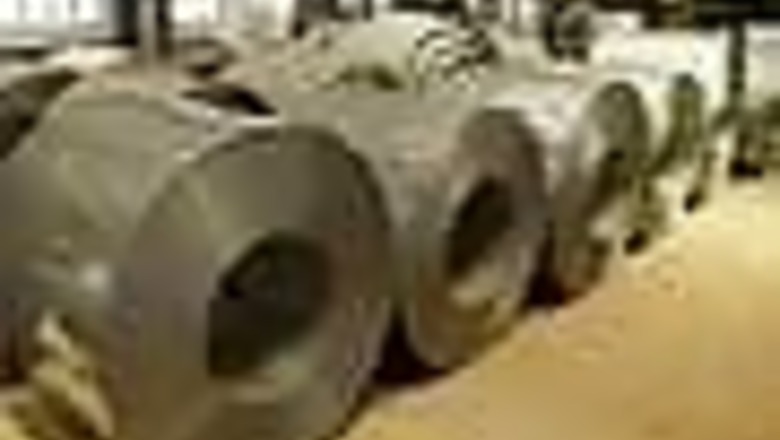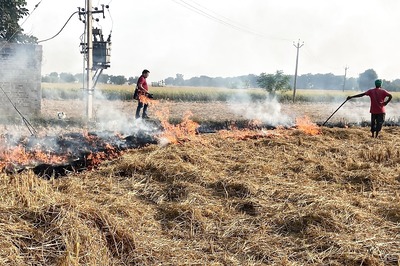
views
Scheme of Examination
The Examination will be conducted in two stages:
Written Test (500 marks)
Interview (100 marks)
Paper I: Objective type
General Intelligence & Reasoning
General Awareness
Part A: General Engineering (Civil & Structural)
Part B: General Engineering (Electrical)
Part C: General Engineering (Mechanical)
Paper II Conventional Type
Part A: General Engineering (Civil & Structural)
Part B: General Engineering (Electrical)
Part C: General Engineering (Mechanical)
Note:
1. In Paper I and Paper II for General Engineering, the candidate can attempt any one part i.e. Part A or Part B or Part C.
2. Candidates are allowed to bring their own Slide–Rule, Non Programmable Calculator, Logarithm Tables and Steam Table for Paper-II only. They are not allowed for Paper I.
3. Candidates qualifying in Paper I only those will be evaluated Paper II.
Mobile Phone or any other electronic / electrical device other than specified Calculator is not permitted.
4. There will be negative marking of 0.25 marks for each wrong answer in Paper I.
5. Candidates, who secure at least the minimum qualifying marks in the written examination, are eligible to appear for Interview. The interview will be held at places as may be decided by the Commission.
6. SC/ST candidates called for interview will be paid TA as per Government Orders. However no TA is payable to any candidate for appearing in the written examination.
7. Canvassing in any form will disqualify the candidate.
Syllabus
Questions in Engineering subjects will be approximately of the level of Diploma in Engineering (Civil, Electrical, Mechanical etc) from a recognized Institute, Board or University and recognized by All India Board of Technical Education. All the questions will be set in SI units.
The details of the syllabus are given below:
PAPER I – Part I (General Intelligence & Reasoning)
The Syllabus for General Intelligence would include questions of both verbal and non-verbal type, it includes questions on:
Analogies
Similarities
Differences
Space visualization
Problem solving
Analysis
Judgement
Decision making
Visual memory
Discrimination
Observation
Relationship concepts
Arithmetical reasoning
Verbal and figure classification
Arithmetical number series.
The test will also include questions designed to test the candidate’s abilities to deal with abstract ideas and symbols and their relationships, arithmetical computations and other analytical functions.
PAPER II – Part II (General Awareness)
Questions will be aimed at testing the candidate's general awareness of the environment around him/her and its application to society. Questions will be designed to test knowledge of current events and of such matters of everyday observations and experience in their scientific aspect as may be expected of any educated person. The test will also include questions relating to India and neighbouring countries especially pertaining to:
History
Culture
Geography
Economic Scene
General Polity
Scientific Research
PAPER II – Part III (General Engineering)
A. Civil Engineering
Building Materials
Physical and Chemical properties
Classification
Standard tests
Uses and manufacture/quarrying of materials e.g. building stones, silicate based materials, cement (Portland), Asbestos products, Timber and Wood based Products, laminates, bituminous materials, paints, varnishes.
Surveying
Principles of surveying
Working of prismatic compass and bearings
Plane table surveying
Theodolite traverse
Adjustment of theodolite
Levelling and contouring
Curvature
Refraction correction
Permanent adjustment of dumpy level
Methods of contouring and uses of a contour map
Tachometric survey.
Soil Mechanics
Origin of soil phase diagram
Definitions
Of void ratio porosity
Degree of saturation
Water content specific gravity of soil grains and unit weights
Grain size distribution curves for different solid and their uses
Atterjerg's limits isi soil classification
Plasticity chart
Coefficient of permeability
Effective stress
Consolidation of soils.
Soil
Calculation shear strength of soils
Direct shear test
Vane shear test
Triaxial test
Soil compaction
Lab compaction
Lab compaction test
Moisture content and bearing capacity of soils
Plate load test
Standard penetration test.
Hydraulics
Fluid properties
Hydrostatics
Measurements of flow
Bernoulli's theorem and its application
Floor through pipes
Flow in open channels
Weirs
Flumes
Spillways
Pumps and turbines.
Environmental Engineering
Quality of water
Source of water supply
Purification of water
Distribution of water
Need of sanitation
Sewerage systems
Circular sewers
Oval sewer
Sewer appurtenances
Surface water drainage sewage treatments
B. Electrical Engineering
Basic Electrical Engg. & Electt. Measurements
Concepts of currents
Voltage
Resistance
Power and energy
Their units
Ohm's law.
Circuit Law: Kirchhoff’s law
Solution of simple network problems
Network theorems and their applications
Electro-magnetism concept of flux
Emf
Reluctance
Magnetic circuits
Electro-magnetic induction
Self and mutual inductance.
A.C. fundamentals
Instantaneous
Peak
R.m.s. And average values of alternating waves
Equation of sinusoidal wave form
Simple series and parallel a.c. Circuits consisting of R.L. and C. Resonance
Measurement and measuring instruments
Moving coil and moving iron ammeters and voltmeters
Extension of range
Watt meters
Multimeters
Megger
Basic Electronics
Electrical machines
Basic principles D
C motors of generators
Their characteristics
Speed control and starting of D.C. motors
Losses and efficiency of D.C. machines.
1-phase and 3-phase Transformers
Principles Of Operation
Equivalent Circuit
Voltage Regulation O.C. And S.C. Tests
Efficiency
Auto Transformers
Synchronous Machines
Generation Of Three Phase Emf
Armature Reaction
Voltage Regulation
Parallel Operation Of Two Alternators
Synchronizing
Staring And Applications Of Synchronous Motors
3-Phase Induction Motor
Rotating Magnetic Field
Principle Of Operation
Equivalent Circuit
Torque Speed Characteristics
Starting And Speed Control Of 3-Phase Induction Motors
Fractional Kw Motors
1-Phase Induction Motors A.C. Series Motor
Reluctance Motor
General, Transmission and Distribution
Different types of power stations
Load factor
Diversity factor
Demand factor
Simple problems thereon
Cost of generation inter connection of power stations
Power factor improvement
Various types of tariffs
Types of faults
Short circuit current for symmetrical faults
Switchgears-rating of circuit breakers:
- Principles of a are extinction by oil and air
- H.R.C. fuses
- Protection earthier leakage
- Over current Buchhotgz relay
- Merz-Prince system of protection of generators & transformers
- Protection of feeders and bus bars.
- Lightning arresters
- Various transmission and distribution systems
- Comparison of conductor materials
- Efficiency for different systems.
Utilization of Electrical Energy
Illumination
Electric heating
Electric welding
Electroplating
Electric drivers and motors
C. Mechanical Engineering
Flow of Fluids
Laminar & turbulent flow
Equation of continuity
Bernoulli's theorem
Measurement of discharge
Flow through pipes
Friction losses
Forces of jet impinging on vanes
Blades
Work done and efficiency
Classification of turbines & pumps
Thermal Engineering
Laws of thermodynamics
Change in entropy in various processes
Properties of steam
Uses of steam table & charts
Construction and Working of Cochran
Lancashire Locomotive and Babcock and Wilcox boilers
Working of steam turbine
Otto and Diesel Cycles
Working of IC engines
Carburetion
Solex Carburettor
Diesel fuel pump & injector
Cooling & lubrication
Production Engineering
Foundry-Different casting processes
Concept of patterns
Types of mould making
Puring defect in castings
Causes & remedies
Welding-classification and types of welding
Testing and defects in welds
Lathes-working of lathe:
- Various tools
- Operation on lathes
- Types of lathes
- Drilling operations performed on drilling machines
- Description
- Principles of working and various operations on machine tools milling machine
- Shaper
- Grinder
- Boring and slotting machines
Strength of Materials
Stresses in composite bars
Relation between elastic constants
Resilience under different types of loads
SF and BM diagrams
Stresses in bearns-combined direct and bending stresses
Struts and columns - Euler's and Rankin's theories
Torsion of circular shafts
Theory of Machines
Simple Mechanisms - Four bar chain
Slider crank chain
Double slider crank chain
Flywheel - Turning moment diagrams
Fluctuation of energy
Friction-in collar and pivots
Plate clutch
Conical clutch
Journal bearing
Transmission of power through flat and V- belts
Gears, profile of gears
Governors-Watt and Hartnell governors
D. Structural Engineering
Theory of structures
Elasticity constants
Types of beams
Determinate and indeterminate
Bending moment and shear force diagrams of simply supported
Cantilever and over hanging beams
Moment of area and moment of inertia for rect. & circular section
Bending moment and shear stress for tee
Channel and compound sections
Chimneys
Dams and retaining walls
Eccentric loads
Slope deflection of simply supported and cantilever beams
Critical load and columns
Torsion of circular section.
Concrete Technology
Properties
Advantages and uses of concrete
Cement aggregates
Importance of water quality
Water cement ratio
Workability
Mix design
Storage
Batching
Mixing
Placement
Compaction
Finishing and curing of concrete
Quality control of concrete
Hot weather and cold weather concreting
Repair and maintenance of concrete structure
RCC Design
RCC beams:
- Flexural strength
- Shear strength
- Bond strength
- Design of single reinforced beams
- Lintels
- Cantilever beams
- Double reinforced beams
- One way slabs
- Two way slabs
- Isolated footings
- Reinforced brick work
- T-beams
- Columns
- Staircases
- Retaining walls water tanks (RCC design questions may be based on both Limit State method and Working Stress method)
Steel Design
Steel design and construction of steel columns
Beams roof trusses plate girders




















Comments
0 comment